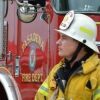It’s common for our urban search and rescue (USAR) teams and mutual-aid crews to respond to disasters, both natural and manmade, but with climate changes exacerbating weather events, there is a strong need for expanded mutual-aid efforts, not only throughout the country but around the world.
Fortunately, the U.S. has some of the best crews in the business. Specifically, I have always been impressed by the automatic-aid and mutual-aid system in place here in California. I believe it is one of the most well designed in the country, if not the world. While these systems typically involve domestic deployments, the California crews are ready for international missions as well.
And they are needed now more than ever.
Approximately 150 firefighters from the United States have been deployed to Australia to help fight the massive wildfires that have consumed millions of acres, killed at least 23 people, destroyed wildlife and countless animals. And at least 100 more U.S. firefighters are scheduled to ship out soon.
These numbers include 20 veteran California firefighters from the U.S. Forest Service’s Angeles National Forest – the first U.S. ground crew to battle this round of wildfires in Australia. The U.S. has sent dozens of incident management teams (IMTs) to Australia already, but this team is thought to be the first that puts boots and shovels in the ground in rough terrain. These experienced teams have worked on engines, Hot Shot crews and aviation helicopters crews, and they often work in remote places, independently with little support.
Department of the Interior’s Office of Wildland Fire Deputy Director Craig Leff underscored the priorities of U.S. forces in a statement from the National Interagency Fire Center: “As the extreme fire danger continues across Australia, the Department of the Interior will continue to do all that we can to support requests for assistance. Our focus remains on helping the people of Australia and keeping people safe in these unprecedented conditions.”
This is not the first time such support has been offered between these countries. Australia and New Zealand have been sending firefighters to the United States for more than 15 years. In 2018, approximately 140 firefighters from Australia and New Zealand helped fight wildfires in California and other Western states. With these historic wildfires now raging in Australia, the help is being repaid.
The last time U.S. firefighters worked in Australia was 2010.
The wildfire conditions facing Australian and California firefighters are similar, with crews facing a similar menace: flaming eucalyptus trees that can shoot off and send dangerous burning embers miles in strong winds. The eucalyptus leaves in Australia are bigger and can send flames farther, heightening the danger.
Although the threat is far from over, the Angeles Forest crew deployment is expected to last 30 to 45 days.
I won’t be surprised if more personnel are sent. If there is any “silver lining” here, it is that the Australia and U.S. have fire seasons occur at different times of year.
The problem is that fire seasons worldwide are stretching longer and longer, and California now experiences a nearly year-round fire season. As fire seasons continue to extend, they will overlap, and the companies that lease firefighting equipment will face competing requests from different parts of the world at the same time. Regions, states and even countries may not be able to depend on external resources if those resources are busy battling wildfires at home.
Fortunately, California has experienced some precipitation this winter. Things are quiet – for now. The recent rains will certainly promote more growth in our foothills, resulting in another explosive fire season this summer.
It’s likely we will see some of Australia’s finest back over here come summer and fall.













